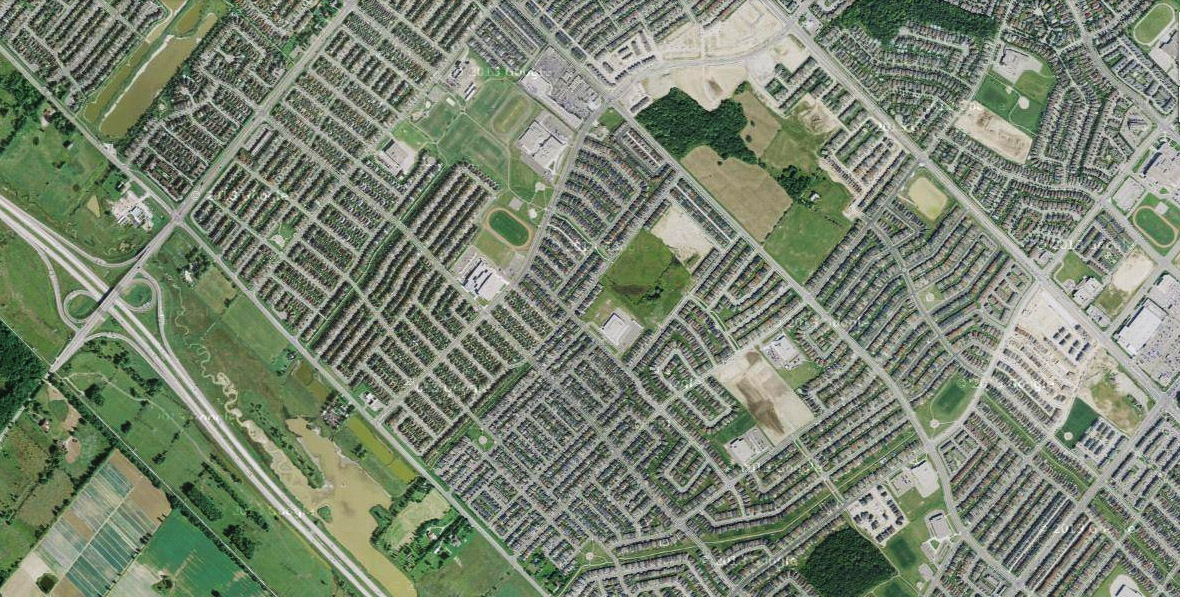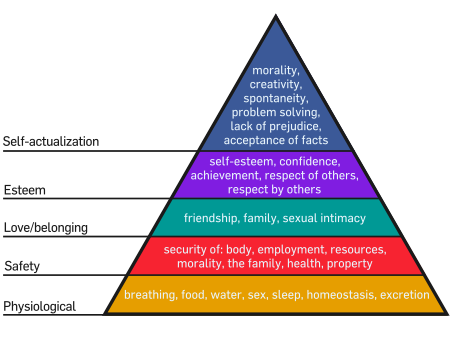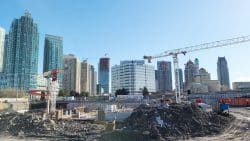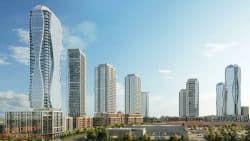The Psychology of Suburbs
They are everywhere, sprawling across the Greater Toronto Area, Canada and the world. This “revolutionary” style of construction planning aimed at providing a safe escape from the scary city within which to raise your family. Touting security, natural space and ease of accessibility as the selling points, suburbs are more popular now than ever. Personally, I believe they are the absolute worst form of development out there, and the reasoning is what psychology of suburbs will explore.

This all began with a morning bike ride through a part of the Platinum Belt when I realized the sheer brilliance of planned suburbs. The masterfully planned psychology of suburbs and what they are intended to deliver. I don’t believe this notion has yet been explored so I’ll dive right in.
Simply put, these subdivisions are designed at their core to keep you working for as long as possible. That is what it boils down to. It’s quite a bold statement, so we’ll begin answering the question of “why?”. When discussing suburbs within this article, I’m referring to the planned sprawls, such as everything currently being built north of Dundas St in Oakville, or Churchill Meadows, even the whole southern part of Milton. A perfect comparison is an ant colony.
The Basics
A suburb consists of a collection of homes, sometimes identical in format, other times there are mixed options such as townhomes and detached homes. These are contained within their own environment and can be accessed by one or more main entrance points. There are usually a few simple parks and occasional trails thrown into the mix for good measure. If you’re lucky, your suburb may be close to a Smart Centre or collection of big box stores which you can visit. You can probably sense the sarcasm being exhibited.
A suburb in my opinion is an evolution of the concept behind the original projects, mind you a lot more luxurious and well thought out. This psychology of suburbs article isn’t intended to offend those residing within, heck I do as well, but rather to shed some light on ideas. Suburbia is enticing, the builders offer a fair selection of model home choices, the pricing is usually quite admirable and the presence of a safe locale is definitely a plus. But really how safe are suburbs?
Psychology of Suburbs on Children
You may not witness crimes seen within inner city neighbourhoods, murders or burglaries. But crime isn’t the only indicator of safety. Most people move into suburbs so they can provide a stable and safe environment within which their children can flourish and grow. Unfortunately, studies have shown that children who grow up in these planned communities are much more depressed than their city counterparts. Girls after the seventh grade are shown to exhibit clinical depression three times more often than their city comparisons. This is unfortunately often combated with substance abuse which is extremely prevalent within these neighbourhoods. It makes you wonder how safe suburbs really are, this is just the tip of the iceberg.
Suburbs are great for younger children, I won’t argue that fact. As soon as they reach the late pre-adolescent years, there is a sense of exploration, adventure, excitement and many psychological changes that occur. Boredom being a huge factor often leads to substance abuse. What else realistically can adolescent teens do in a suburb after sports, going for walks and socializing at home have been exhausted. There is no sense of growth and I’ll explore this point later on. For adolescents growing up within cities it has been proven that there is a lower count of depression and drug use. This could be due to the living examples reflected in beggars and homeless people on the streets. The harshly projected signs of what happens when you trudge down that path. Unfortunately the psychology of suburbs surrounds these fragile adolescents with manicured lawns, orderly trees and a literal escape from reality. There are also other avenues of entertainment for the youth within cities. Sure there are noisy streets, the risk of getting struck by a car, smog and pollution. There are also cafés, museums, galleries, theatres and much more all within walking distance. There’s also another psychological factor at play here; parents. As I’ll explain later, suburbs are a consumer of time. Given conflicting work/school schedules parents and teens begin to interact less and less, especially missing communal meals. This is often the start of depression and faltering school attendance which eventually can snowball into far worse scenarios because the adolescents do not have a support system, but many, many pressures.
Psychology of Suburbs on Time/Perception
The degenerative effects on adolescents caused by suburbs can be coined as an abstract fact, understandable. However the main point of this article is the discussion of time and the bigger picture. Most people who reside in suburbs work in the city or at minimum, a thirty minute commute. This takes away a huge portion of your day where you are essentially burning money sitting in rush hour traffic idling away or crowding like sardines into a public transportation line. It’s the stark reality. You also live in a very organized, well presented system of barracks for lack of a better term. The typical day consists of waking up, commuting to work, returning home, enjoying some free time and repeating the process. The schedule will depend on your type of employment.
The grocery and shopping stores are generic big box. Therefore you go in and out as quickly as possible. Everything is designed to be systematic. Store layouts rarely change and you become accustomed to this set structure. Usually throughout the work week most people are too busy being employed and commuting. Therefore weekends are left as the only viable option for necessary shopping. Sadly, this becomes everyone’s only option, and then you have three or four suburban populations all converging on the local shopping plaza in cars to shop. The sheer mass of people causes backups, and basically a “weekend rush hour”. This uses up valuable “free” time. Even at best, it will leave you with a Sunday completely free. After finishing the consumerism trip, everyone flocks back to their suburban dwellings.
I believe that ant colony analogy mentioned earlier is starting to become clearer. Lets keep going. The psychology of suburbs also takes into account our motivation. We as creatures are always seeking comfort, once we enter a comfort zone, we stay there. Maslow’s Hierarchy of needs is an excellent tool with which to analyze how suburbs play into this reward system. If you can afford to live in a suburb (They aren’t all luxury neighbourhoods anymore) then you’ve reached the turquoise level in Maslow’s Hierarchy as pictured. The esteem level is where the psychology of suburbs begins to show its paradoxical brilliance.

A suburb has very limited variety when it comes to social class for the most part. They do sometimes include lower priced townhomes adjacent to million dollar homes. I know these two statements contradict each other but observe how everything plays out. If you reside within a townhome, all of your neighbours are of similar financial status and esteem. Considering the amount of time spent outside of the community, there are very few factors that can motivate an individual. Probably the highest aspiration would be to upgrade from the townhome, to the detached home within the same neighbourhood. Therefore the esteem level is filled. There is no sense of urgency or motivation to increase your social status because everyone you are exposed to on a daily basis is of similar stature. This creates a stagnant state of evolution, both socio economically and creatively. Since the esteem level is so easily attained once you’ve nestled into a suburb the only remaining hierarchy is self actualization. Voila, community councils, volunteer services etc, etc are formed to reach this self actualizing nature. I’m not saying these are bad things to have, but it creates a limiting cap. It compartmentalizes an entire, brilliant human existence into a systematic schedule that is defined by the confines of the suburban community. It may sound strange, but if you take a moment to really think about the circumstances, it’s hard to argue the validity. Each person has a defined role just like in an ant colony and follows it. What suburbs offer are beautiful comforts, but these comforts have a caveat that eliminate individuality.
Now to look at all these negative aspects, one wonders what are the solutions. The first is to stop this manic sprawling of suburbs in all directions, thankfully we have the green belt to keep us somewhat under control. Suburbs are graciously profitable for builders as they are very simple to design and build compared to other styles of housing. Ideally given the population increases, high density development, including but not limited to high-rises is optimal. Indeed they offer even less individuality when it comes to the design of living space, but this is greatly offset by the surrounding social benefits. On the other end of the scale there is the option of villages such as Streetsville, Port Credit, Downtown Oakville, Mimico, Clarkson, etc. These can be classified as suburbs technically, but they differ greatly in design and atmosphere as anyone would agree. They give a city feel without the skyscrapers. They offer places of creative exploration, social gatherings and creativity. These are all things that us as humans require to keep a healthy mind. Unfortunately, the contrasting design and psychology of suburbs has one goal, to keep the workers of our society in a synchronized schedule with which to benefit those who were fortunate or persistent enough to escape this cycle.
Without extending this article much further I’d like to wrap things up. Suburbs offer a good short term option but in my opinion are a terrible use of scarce local land, the entire North Oakville neighbourhood is an abomination. It was an ideal area to create an exclusive proper downtown which reflects the vision and ideals of Oakville as a town. If you ever want to see first hand all that’s been discussed in this article in physical form, just take a drive down Dundas St in Oakville, I’m sure you’ll begin to agree with everything. Living within a city is breathtaking, not because of constant vehicle exhaust surrounding you, but because you realize that you’re not bound by a car to explore and develop yourself as a person. The freedom to walk to entertainment and things that fulfil your craving for satisfaction. The sheer variety of options. Imagine for an adolescent who cannot drive yet and who is at their prime developmental stage, this freedom is phenomenal. Unfortunately the orderly serenity of suburbia simply doesn’t provide. If you’re now thinking of selling your home because of this article, make sure to contact us. I hope this provided a unique, sarcasm riddled point of view on a subject which really should be discussed more.




